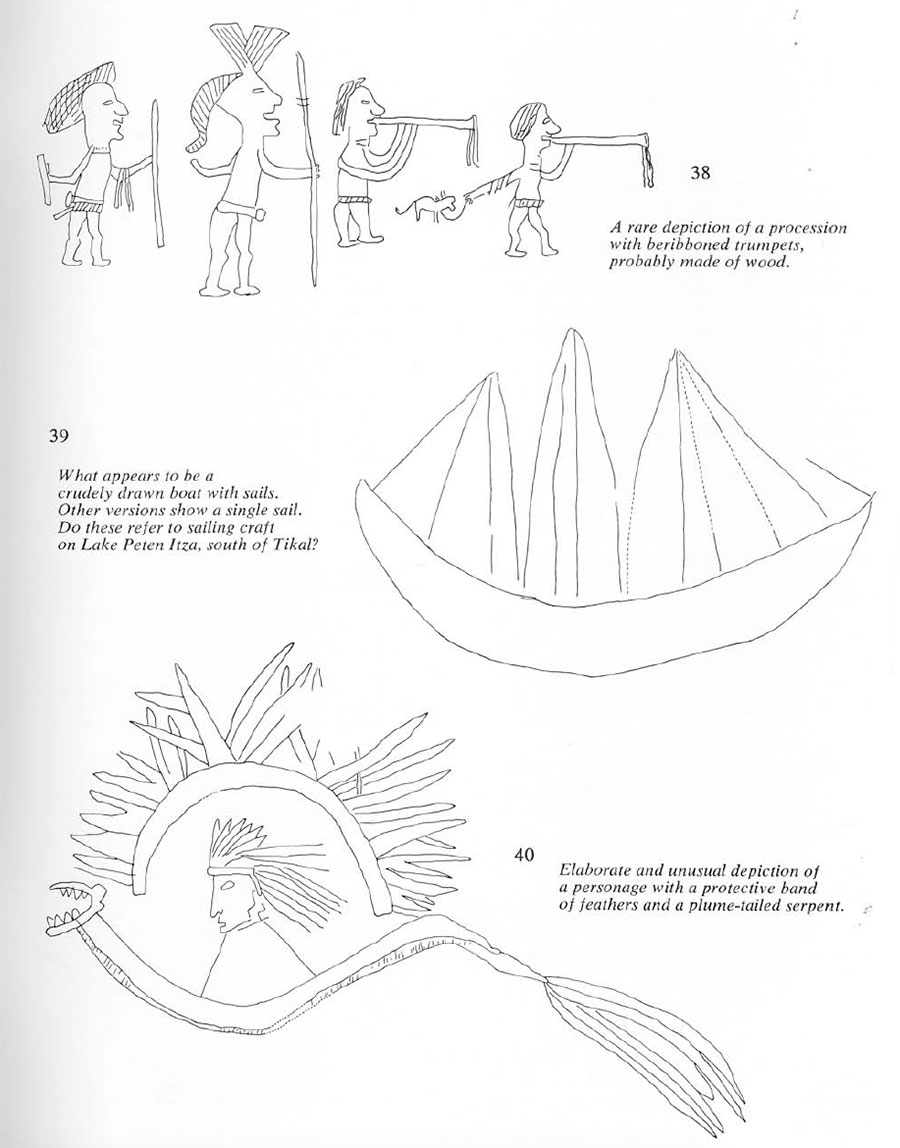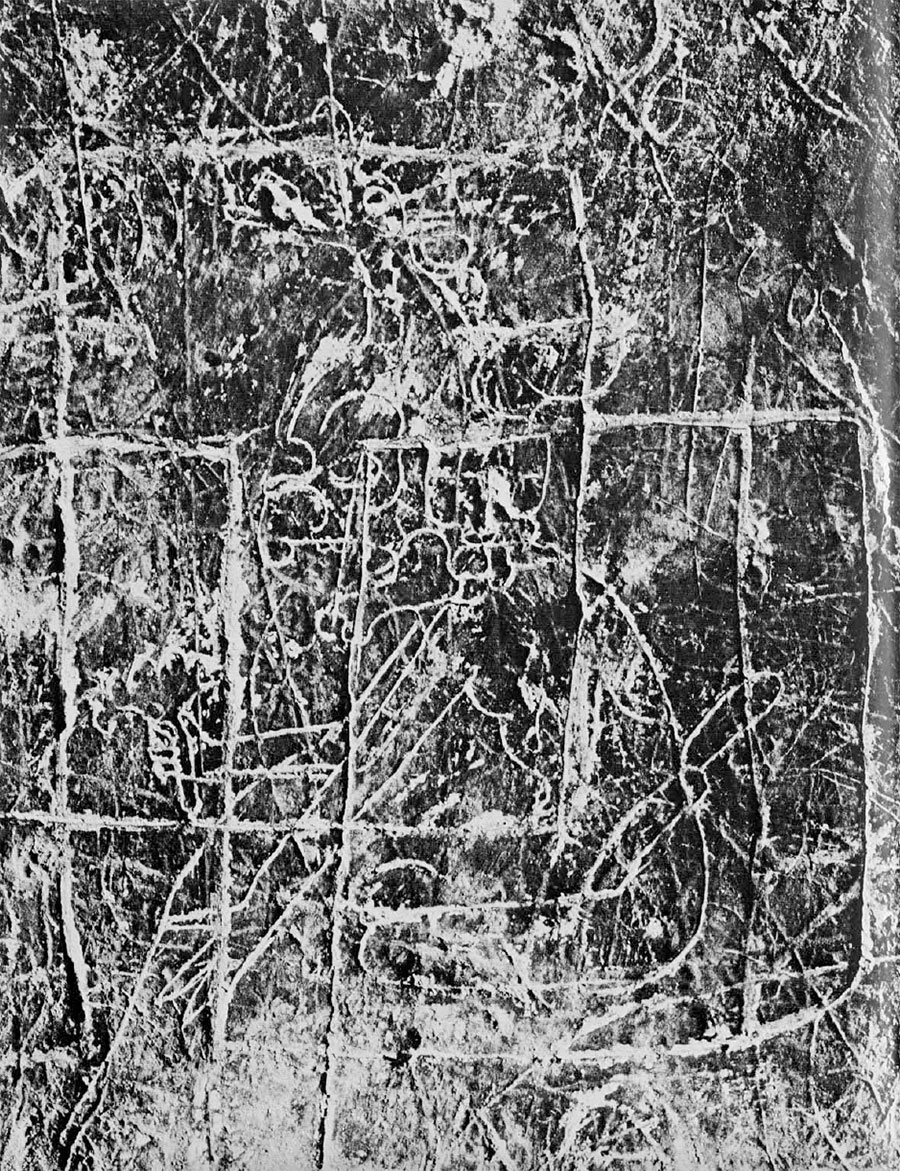
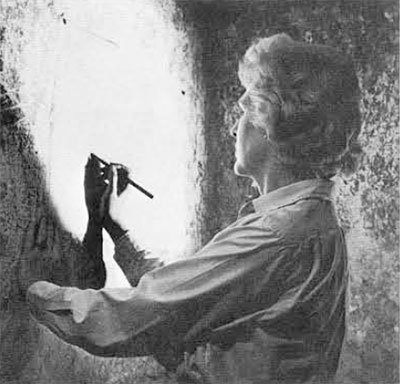
Visitors to Tikal, the great Maya religious site in the lowlands of Peten, Guatemala, are always intrigued by the many and varied drawings scratched on the plaster walls of its temples and multi-roomed “palace” buildings. Often the observer is skeptical of the authenticity of these incised representations and finds it hard to believe that they could have survived the thousand years, or more, since they were put there by Maya hands. Excavation, however, has now revealed that in Tikal this particular form of art, known as graffito, is at least as old as the time when the building in which it appears was in use. The “art” of graffito is, of course, ubiquitous and timeless and has been found on many varied surfaces from Neolithic caves to the telephone booth and subway wall of today. In its less formal phases is has been called doodling.
In Tikal, unfortunately, the practice of graffito has not been confined to the period of occupation by the Maya. Countless passers-by and visitors, not to mention little clawing animals, have added their own versions and in doing so have defaced many of the original drawings. Not all of the more recent efforts are without interest. The signature of the famous archaeological pioneer, “Teoberto Maler 1895 – 1904” appears on a door jamb of the palace building bearing his name and in which he lived while recording the ruins during those years. “T M Morales–? 17 1886–vinieron 14 personas” is scratched on the wall of another room in the same building. But for the most part, the meaningless initials, dates, and lines only make the task of deciphering and recording the authentic graffiti more problematical. Added to this difficulty are the confusion and profusion of the Maya incisions; figures are superimposed upon figures, then defaced by apparently chaotic lines. This suggests a time sequence of repainting, or replastering, each period having its series of graffiti. With the ultimate disintegration of the surfaces down to the original hard plaster, the penetrating incised lines have merged.
Many of the original drawings are apparent to even a casual glance, but countless more are obscure, hidden in dark corners, or under the mossy green mold which covers most of the exposed walls of buildings. The “artists” seem to have made use of every available area on which to put their messages. The results of their efforts are as varied as the talents of the artists themselves. Painstaking scrutiny of the walls, the floors, and even the vaults of the structures with the aid of a flashlight becomes rather like a treasure hunt. A few shadow lines are picked up by the beam which, when carefully followed and traced, synthesize into a surprisingly lovely human form such as that illustrated as number 7, or, more often, into something like 36 and 37, for which there is no immediate explanation.

When were the graffiti made and what is their meaning? Both questions are difficult to answer. The first can be partially limited, at least, by the approximate dates of the buildings in which the graffiti occur. They could not be of a date earlier than the construction of the building; but, unless this was buried in ancient times, they might be much later, even of the Post-Classic era following the collapse of priestly control about A.D. 900, or they might possibly have been made by subsequent intermittent occupants and visitors to the site. When first found on the more or less protected walls of standing structures, they were thought to have been made by decadent peoples long after Tikal was abandoned as a formal religious site. As excavation has progresses, however, it has become apparent that this informal art flourished at all periods in which there was substantial architecture. Graffiti have been found on buildings dated back perhaps as early as 100 B.C. The walls of the rooms of an Early Classic A.D. 500 temple, partially destroyed and completely buried beneath the later Str. 5D-33 about A.D. 700, are literally covered with graffiti. Here, in places, the state of preservation of the walls makes it possible to follow the sequence of the drawings. A thin deposit of some dark, sooty substance had been incised with figures such as 21 and hieroglyphs (20), as well as with the usual indeterminate, random lines. Careful removal of this deposit revealed on the plaster wall beneath a maze of lines which were not previously visible. Out of the confusion one could eventually trace abstract masks, headdresses, crudely drawn human figures, and hieroglyphs (19). On another wall of this buried temple the graffiti were apparently incised after partial disintegration of the plaster itself. The lines could be clearly followed across broken areas; obviously the building was in a state of disrepair when the drawings were made. Here, also, the question of the authenticity of the five-pointed star motif which appears frequently in Maler’s Palace (14), is answered; for here identical stars are to be seen on walls buried since approximately A.D. 700.
What the Maya meant by these infinitely varied representations of their life and times is still an enigma. Not only at Tikal, but throughout the lowland Maya area, graffiti have been observed and recorded. The evidence does not indicate that these line drawings were meant to be a formal wall decoration, for there is little or no attempt at spacing and continuity of design. They cannot be compared to the stylized, ceremonially important wall paintings found at Bonampak and Uaxactun. So far, only in Tikal Temple II (Str. 5D-2), on the door jambs between the first and second rooms, is there a suggestion of an actual decorative panel. Here are traces, drawn rather than incised, of something comparable to the artistry of the carved lintels of the great temples, or of the stone monuments; and these traces have been superseded by later graffiti.
As has been mentioned, the great variety of subject matter and talent only adds to the puzzle. Was the privilege of drawing on the temple and palace walls one that was granted, during so-called Classic times, to the ruling class only? Doubtless, while the buildings were in active use this could have been true. But a comparison of the representation of a giant jaguar deity standing majestically over a seated priest as it appears on the wooden Lintel 3 of Temple I at Tikal, with the crudely drawn forms of the same motif in 5 and 36 suggests a comparable difference of social status in their makers. Certain buildings carry a predominance of a particular subject. Maler’s Palace (Str. 5DF-65) has many versions of the “Looming deity” (11), most of them on adjacent walls of the same room, each possibly a decorative offering by an individual. The so-called Five Storied Palace (Str. 5D-52) abounds in boatlike representations (39) which may be sailboats, or possibly crude astronomical figures. Temple II (Str. 5D-2) has many architectural portrayals of pyramids surmounted by varied temple buildings (27). Very occasionally, graffiti convey an understandable story. 38 is obviously a ceremonial procession and, rather than representing a mascot, the small, unidentifiable animal is probably being led off to sacrifice amid a fanfare of trumpets. The “Execution Scene” in 23, one of the most famous Maya graffiti, dramatically presents the prisoner bound to posts, his body pierced by the spear or arrow hurled by the executioner who wears a strange, sinister headdress. The figure on the left appears to be that of a woman whom Maler fancifully described as the grief-stricken wife of the victim. To be mentioned here, perhaps, are the facts that there are few portrayals of the female form and that there is nothing that could be interpreted as pornographic in the graffiti so far recorded at Tikal.
There is always the danger of being subjective when attempting an interpretation of the graffiti, or even when tracing them off the surfaces. If every “might be” line were followed, the thus invented drawings would far outnumber the actual. Allowing a flight of imagination, we might interpret the groups of parallel lines which occur in many of the buildings as the notches on a gun, a line for each sacrificial victim. More likely they are simply methods of counting or calculation. In studying the drawings, it became evident that they fall into two categories: descriptive or demonstrative drawings and pictorial offerings to the gods. Under descriptive drawings may be included those made by priests or officials demonstrating costumes, headdresses, thrones, temples, standards, and other ceremonial regalia as well as important dates, all of which could have been used for instruction. Also in the descriptive category would be graffiti presumably made by the ordinary citizen: things observed, personal dates, even possible self portraits (33). Realistic representations of animals, reptiles, and birds can be matched by abstractions, grotesques, and imaginative drawings. A version of the Mesoamerican game of patolli occurs occasionally scratched in the floors or bench surfaces of palace-type structures. Incised hieroglyphs and texts also appear (19,20).
From a religious pint of view, these multitudinous graffiti could have a very special and individual significance in the promulgation of magis. There exists the possibility of curative magic for illnesses, or troubles; of increase magic to make more animals and birds when they became scarce, or even to encourage the growth of crops after a failure of some kind. Family crests and totel animals of family lineages may have been presented to the deities, the artist seeking special favors or expressing gratitude.
Through the generosity of Colonel Truman Smith, funds have been made available for the systematic recording, study, and publication of the Tikal graffiti. Comparative study and analysis to be made when the recording is completed will shed light on some of the questions raised here. Aspects of the life of the Maya which are not recoverable by other means and which may be valuable contributions to the whole story are bound to be revealed by these seemingly extemporaneous, but probably often traditionalized drawings.
The illustrations on the following pages are all at the linear scale of one to four. The dates given pertain to the earliest time the graffiti could have been made.
Maler’s Palace (Structure 5D-65) A.D. 700-800
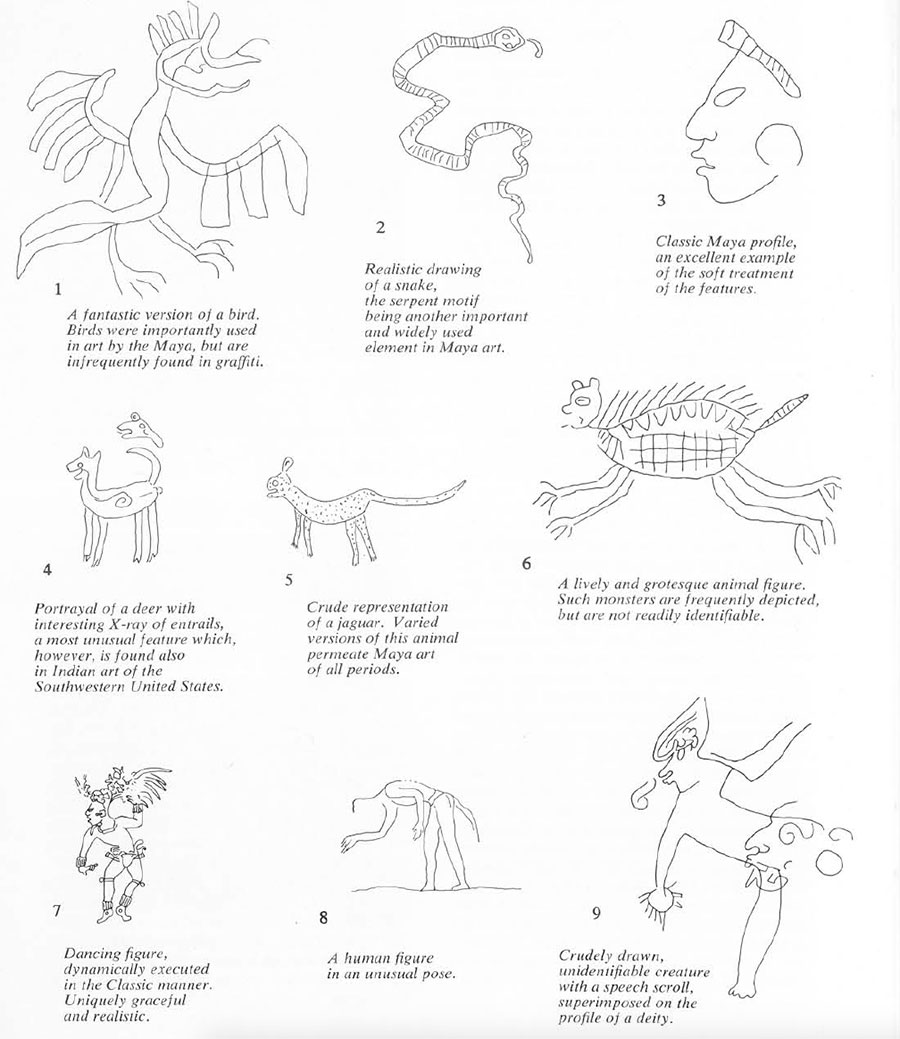

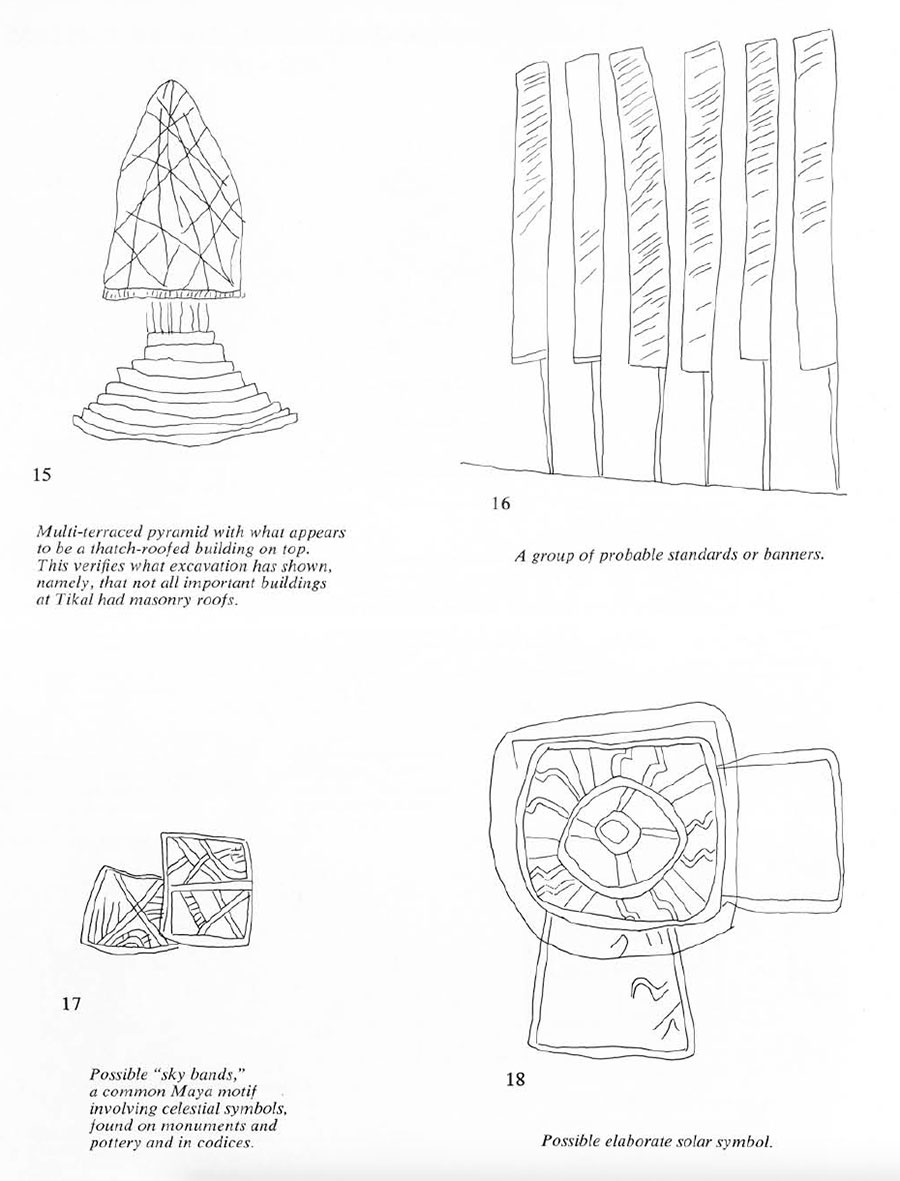
Structure 5D (Early Classic Version) A.D. 500
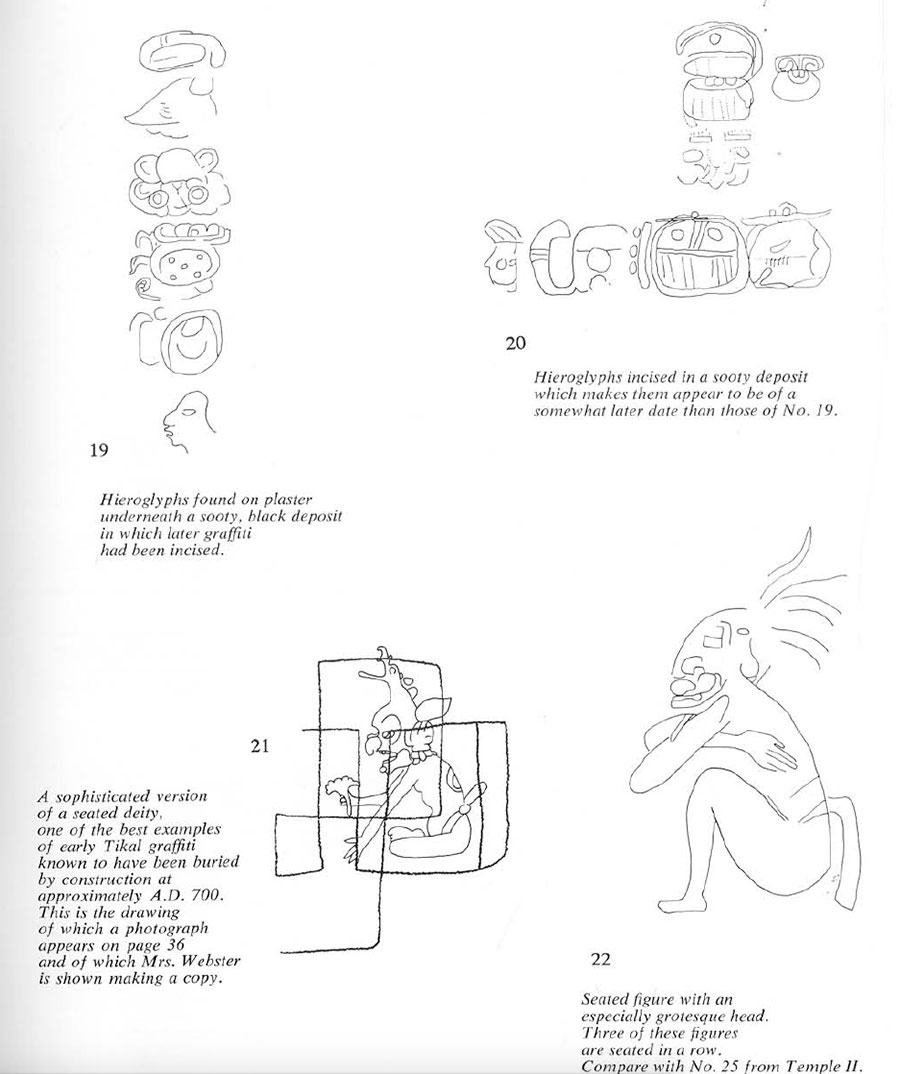
Temple II (Structure 5D-2) A.D. 700
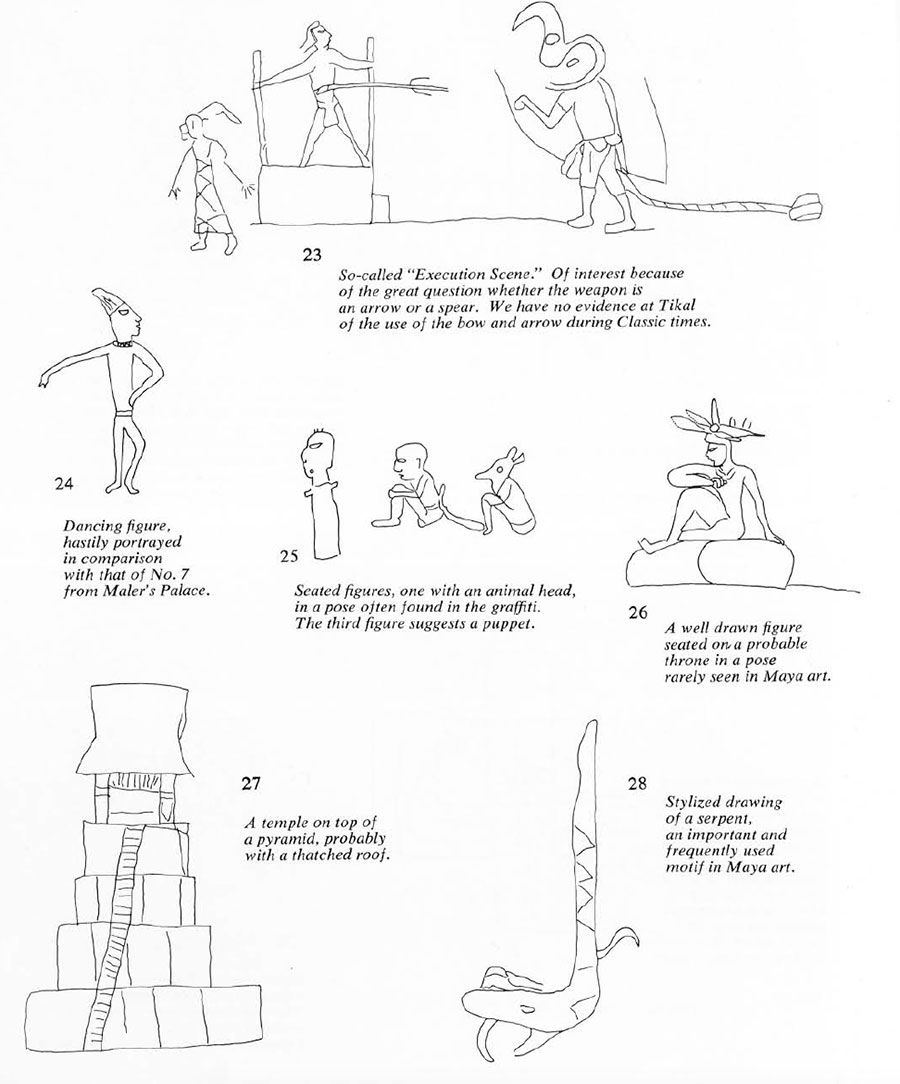
Temple of the Inscriptions (Structure 6F-27) A.D. 700-800
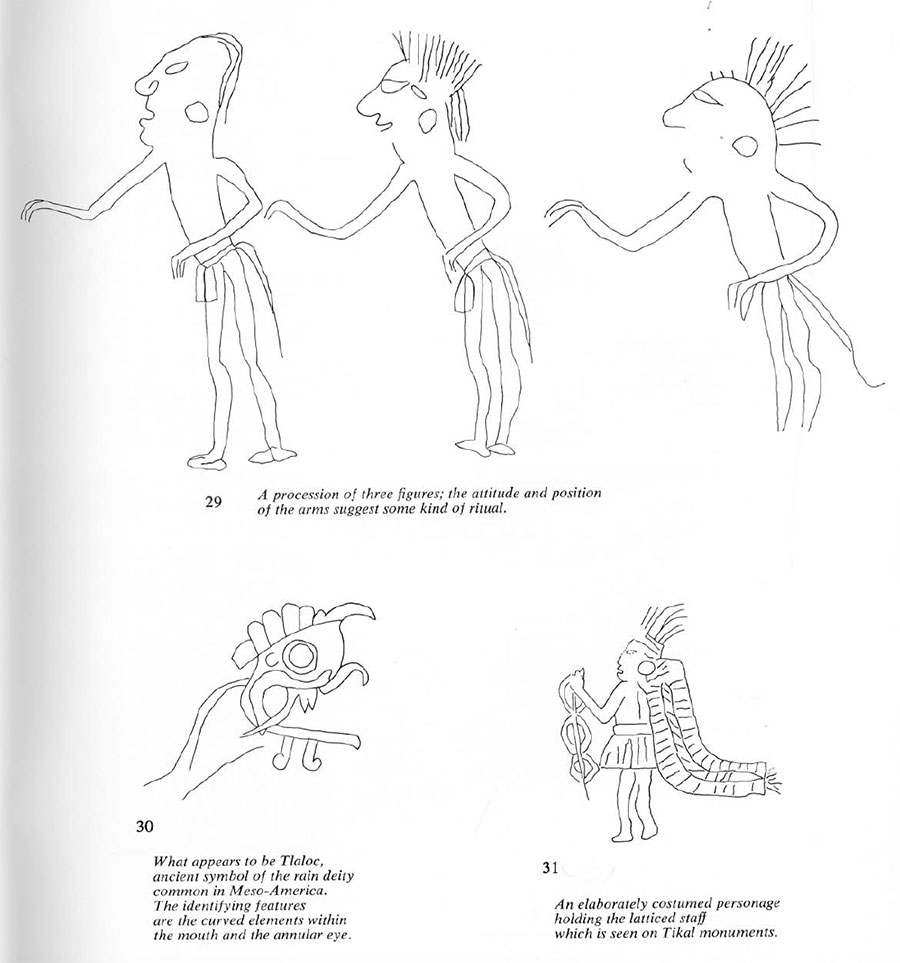
Bat Palace (Structure 5C-13) A.D. 700-800
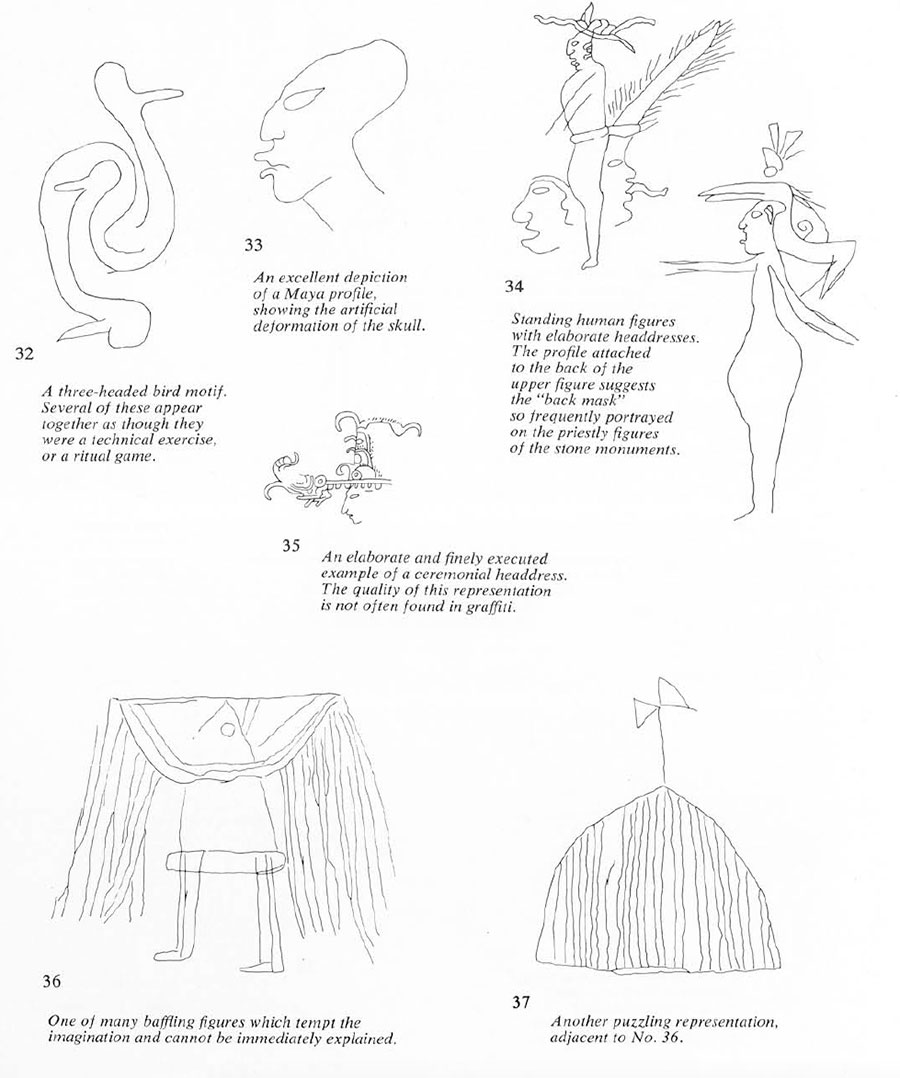
Five Storied Palace (Structure 5D-52) A.D. 700-800
